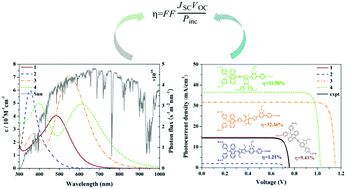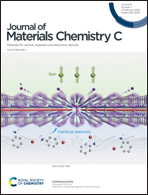Accurate estimation of the photoelectric conversion efficiency of a series of anthracene-based organic dyes for dye-sensitized solar cells†
Abstract
Photoelectric conversion efficiency (PCE) is one of the crucial indicators to determine the overall performance of dye-sensitized solar cells (DSSCs), and accurate estimation of PCE is a feasible strategy for developing high-performance DSSC devices. In this contribution, we strategically designed a series of anthracene-based organic dyes 1–4 by introducing different π-bridge or auxiliary acceptor groups. Their photovoltaic properties were explored by first-principles calculations coupled with the normal model and improved normal model. It is found that the introduction of an electron-rich thieno[3,2-b]thiophene-based π-spacer in dye 2 induces a blue-shift of the maximum absorption band with respect to dye 1, while the inclusion of an electron-deficient diketopyrrolopyrrole-based π-bridge in dye 3 and a thieno[3,4-b]pyrazine-based auxiliary acceptor in dye 4 can remarkably extend the optical absorption into the 550–650 nm region. In addition, the open-circuit voltage (VOC), short-circuit photocurrent density (JSC), fill factor (FF) and the corresponding PCE (η) were evaluated by the improved normal model. The estimated results of dye 1 (VOC = 757 mV, JSC = 14.63 mA cm−2, FF = 0.85, and η = 9.41%) reproduce very well the experimentally available data (VOC = 760 mV, JSC = 14.25 mA cm−2, FF = 0.75, and η = 8.08%), suggesting that the improved normal model is an accurate and general method to predict the photoelectric properties of organic dyes. More importantly, dyes 3 and 4 are predicted to exhibit extremely high PCEs of over 32%, both of which are expected to be potential candidates as metal-free organic dyes applied in DSSCs.



 Please wait while we load your content...
Please wait while we load your content...